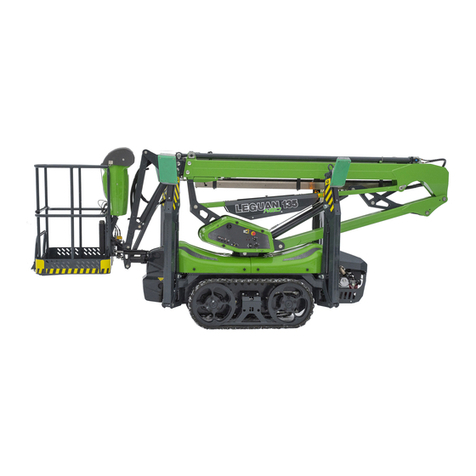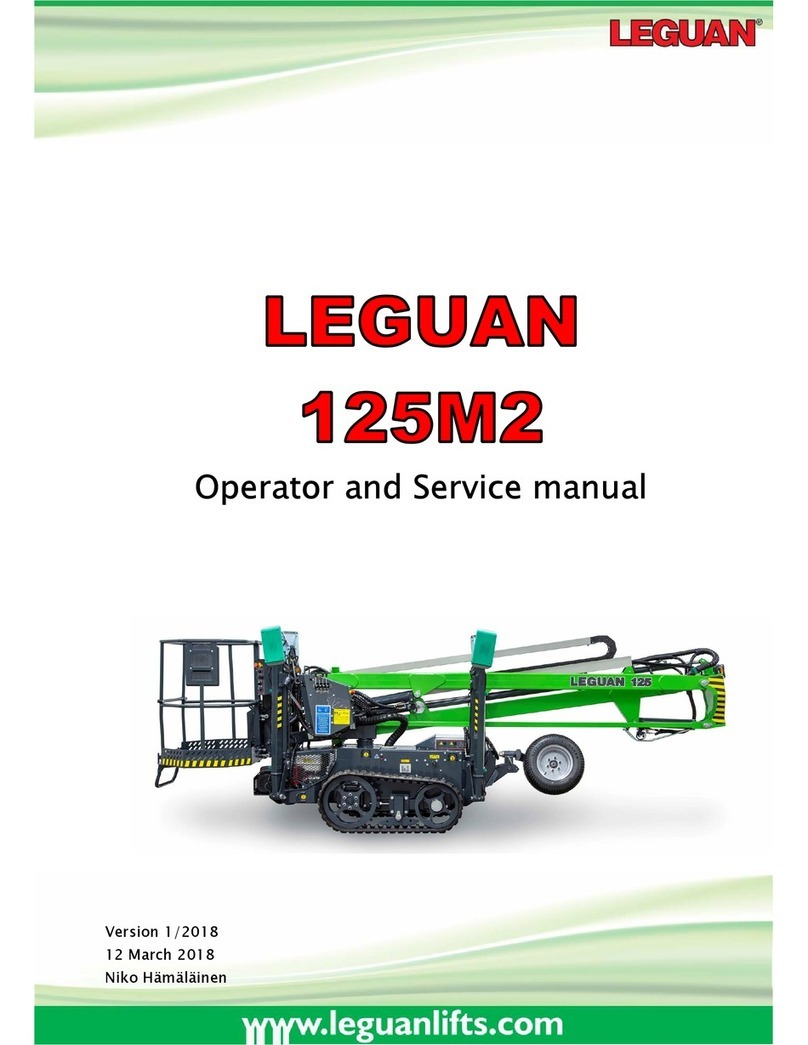2
_________________________________________________________________________________
Contents
1. INTRODUCTION AND WARRANTY CONDITIONS 4
1.1 INTRODUCTION 4
1.2 WARRANTY CONDITIONS 4
2. GENERAL INFORMATION 7
3. TECHNICAL SPECIFICATIONS, LEGUAN 165 9
4. SIGNS AND STICKERS 11
5. SAFETY INSTRUCTIONS 12
5.1 BEFORE STARTING OPERATION 12
5.2 RISK OF TIPPING OVER 13
5.3 RISK OF FALLING 13
5.4 RISK OF COLLISION 14
5.5 RISK OF ELECTRIC SHOCK 14
5.6 RISK OF EXPLOSION /FIRE 14
5.7 DAILY INSPECTION BEFORE STARTING OPERATION 15
5.8 USE OF EMERGENCY STOP SWITCHES 15
6. CONTROLS AND SWITCHES 16
6.1 CONTROLS IN PLATFORM 16
6.2 CONTROLS AT GROUND LEVEL 17
6.2.1 Battery disconnect switch at ground level 17
6.2.2 Controls on the control valve box at ground level 17
6.2.3 Emergency lowering buttons at ground level 17
6.2.4 230V - Connection and switches (Option) 18
6.2.5 Lower control panel (Option) 18
6.2.6 Safety functions override in emergency situations 19
7. STARTING THE ENGINE / ELECTRIC MOTOR 20
7.1 ADDITIONAL INSTRUCTIONS FOR WINTER USE 21
8. DRIVE CONTROL 22
8.1 DEFINING THE GRADIENT OF THE SLOPE 23
8.2 CRAWLER TRACK CHASSIS 23
8.2.1 Instructions for working environment 24
8.2.2 Operating instructions 24
9. OPERATION OF THE OUTRIGGERS 25
10. OPERATION OF THE BOOMS 26
11. EMERGENCY LOWERING 27
12. ENDING THE OPERATION 28
13. TRANSPORTING INSTRUCTIONS 29
14. SERVICE, MAINTENANCE AND INSPECTION REGULATIONS 30
14.1 GENERAL INSTRUCTIONS 30
15. SERVICE INSTRUCTIONS 32
15.1 SERVICES AND CHECKS,MAINTENANCE SCHEDULE 32
15.2 GREASING OF THE MACHINE 33
15.3 GREASING DIAGRAM 34
15.4 HANDLING OF FUEL AND REFUELING 35
15.5 HYDRAULIC OIL AND OIL FILTER CHANGE 35
15.6 HYDRAULIC OIL LEVEL 35
15.7 BATTERY CHECK 36
15.8 CHECK OF SET-UP OUTRIGGER CONTROL SYSTEM 36
15.9 WATER LEVEL CHECK 37






























